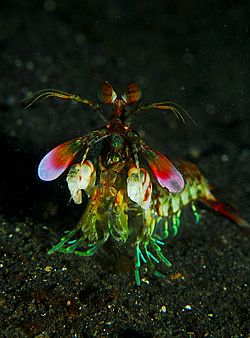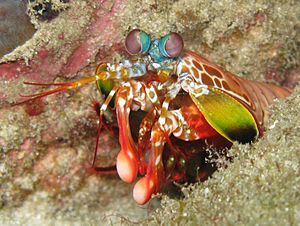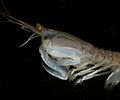Mantis shrimp facts for kids
Quick facts for kids Mantis shrimp |
|
|---|---|
 |
|
| Scientific classification | |
| Kingdom: | |
| Phylum: | |
| Subphylum: | |
| Class: | |
| Subclass: |
Hoplocarida
|
| Order: |
Stomatopoda
Latreille, 1817
|

Mantis shrimps are amazing sea creatures. They are a type of crustacean, like crabs and lobsters. But don't let their name fool you! They are not actually true shrimps.
These animals belong to a special group called the order Stomatopoda. There are about 400 different kinds, or species, of mantis shrimps.
Mantis shrimps are fierce predators. They catch their food by hitting it incredibly fast. They get their name because they hold their bodies in a way that looks like a praying mantis.
They also have very large and complex eyes. Some mantis shrimps can grow to be 30 centimeters (about 12 inches) long! They are often brightly colored and live in warm, shallow waters. You can find them in places like coral reefs in tropical and subtropical areas.
Contents
How Mantis Shrimps Attack Their Prey
Mantis shrimps use one of two main ways to attack other animals. Each species is built for a specific hunting style.
Spearers: Fast and Pointy
Some mantis shrimps are called Spearers. They have sharp, spiny claws with barbed tips. They use these claws to stab and catch their prey. Imagine a tiny harpoon!
Smashers: Powerful Punchers
Other mantis shrimps are known as Smashers. They have a strong, club-like arm. They use this club to hit and break open the shells of their prey. They also have a simpler spear, which they use when fighting other mantis shrimps.
Both types of mantis shrimps strike very quickly. They unfold their claws and swing them at their prey. They can cause serious damage, even to animals bigger than themselves!
Smashers are especially fast. Their strikes are among the quickest movements known in the animal kingdom. They hit their prey with incredible force, like a tiny bullet.
Smashers use their powerful clubs to crack open the shells of snails, crabs, molluscs, and rock oysters. Spearers, on the other hand, prefer softer animals like fish. Their barbed claws can easily slice and snag this kind of food.
The Amazing Cavitation Shock Wave
When mantis shrimps strike so rapidly, something incredible happens. They create tiny bubbles in the water between their claw and their target. This is called cavitation.
When these bubbles collapse, they create a powerful shock wave. This means their prey gets hit twice! First, by the mantis shrimp's claw. Then, by the shock wave from the collapsing bubbles right after.
Even if the mantis shrimp misses its target, the shock wave alone can be strong enough to stun or even kill the prey. It's like a double punch!
Mantis Shrimp Eyes: Super Vision
Mantis shrimps have truly amazing eyes. Their eyes are on stalks that can move around independently. This means one eye can look forward while the other looks backward! Scientists believe they have the most complex eyes in the entire animal kingdom.
Mantis shrimps can see things humans can't. They can see polarized light, which helps them navigate and find prey. They can also see colors outside the normal visual spectrum that we see.
Some species have at least 16 different types of cells that detect light. For comparison, humans only have four! Twelve of these cells help them see many different colors, including ultraviolet light. The other four help them see polarized light.
Why Their Eyesight is So Special
The incredible eyes of mantis shrimps help them in many ways. They might use them to recognize different types of coral. They can also spot prey that is often transparent or hard to see. Their eyes help them find predators, like barracuda, which have shiny scales.
Because mantis shrimps hunt with such fast claw movements, they need very accurate depth perception. Their amazing eyes help them judge distances perfectly.
During mating, mantis shrimps actually glow, or fluoresce. The light they produce matches the special colors their eyes can see. This helps them find a mate.
Female mantis shrimps are only ready to have babies during certain times of the tidal cycle. Being able to see the phase of the moon might help them know when it's the right time to mate. This also helps species living in shallow water understand the size of the tide.
Images for kids
-
Drawing of a mantis shrimp by Richard Lydekker, 1896
-
Mantis shrimp caught at Hậu Lộc, Thanh Hóa, Vietnam
See also
 In Spanish: Estomatópodos para niños
In Spanish: Estomatópodos para niños










